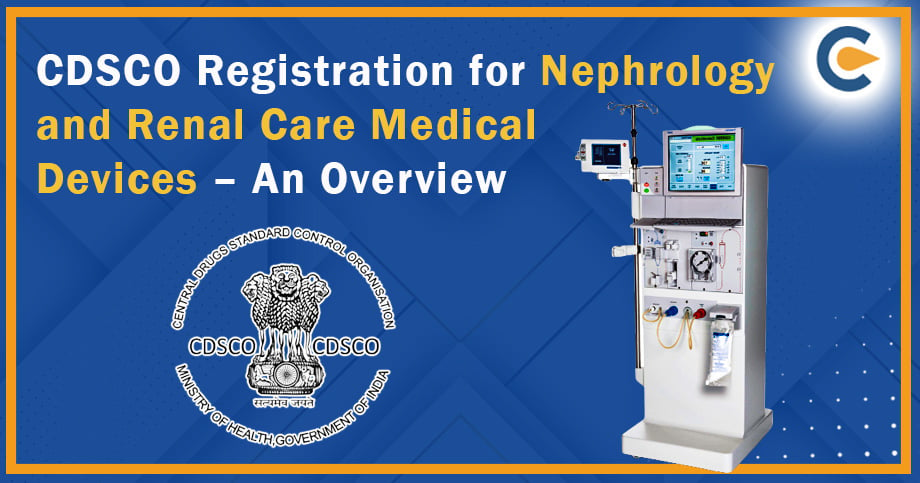There is an assortment of medical devices used in the diagnosis and treatment of kidney-related diseases. The devices that fall under the class A and B risk categories will now come under the ambit of CDSCO. The registration of such devices has been made compulsory by the authority, which will become effective from 1st Oct 2022. It’s worth noting that only manufacturers and importers of such devices fall under the CDCSCO licensing scheme. In this write-up, we will learn about the CDSCO Registration for Nephrology and Renal Care medical devices in detail.
What is Nephrology and Renal care?
Nephrology is a medical field that deals with the study of kidneys and their diseases. The nephrologist deals with the treatment and diagnosis of kidney-related conditions. The kidneys ensure the optimal presence of fluid and electrolytes in the body. Renal clearance test measures the kidney’s capacity to segregate compounds from the human blood. Further, the creatinine clearance test gauges the glomerular filtration rate. Weakened kidney performance can lead to waste build-up within the blood, causing various diseases in the human body.
List of Notified Medical devices relating to Nephrology and Renal Care
The category concerning Nephrology and renal care comprises a total of 15 medical devices categorized on a risk-wise basis and intended use. However, Class A and B devices will only come under the ambit of CDSCO registration. Here is the list of devices requiring CDSCO approval:
- Urinary Stone Retrieval basket
- Crimp for plier, Hemodialysis
- Chair, Haemodialysism electrically powered/manual
- Dialyser connector
- Laser Lithotripsy fiber/suction guide
- Flexible fiber optic nephoscopy
- Hemodialysis blood tubing/Extracorporeal systems
- The peritoneal dialysis catheter guidewire
- Rigid nephroscope
- Peritoneal dialysis ultraviolet irradiation unit
- Stunts thrombus suction set
- Rigid nephroscope
- Portable continuous peritoneal perfusate thermal conditioner
- Extracorporeal circuit waste bag
- Citric acid hemodialysis system cleaning cartridge
What is the Role of CDSCO?
CDSCO stands for Central Drug Standard Control Organization is a government-backed legislative body that regulates the manufacturing and selling of drugs and medical devices in India. The authority underpins various norms and guidelines to ensure the production and trading of safer pharma products. CDSCO devises guidelines in accordance with the Drugs and Cosmetic Act 1940[1]. Presently, 37 categories of medical devices fall under the CDSCO’s licensing scheme. The Drugs and Cosmetic Act 1940 governs the entire supply chain of these medical devices and it even applies to importable goods.
Legal Definition of the Medical Devices
Medical Devices Amendment Rules 2022 defines medical devices as devices utilized in typical medical practice such as impact appliances, medical apparatus, and instruments. As per the said rules, a device is qualified to be called a medical device if it serves the following purpose.
- Help in diagnosing or treating the body’s disorder, disease, or injury.
- Help in supporting and sustaining life
- Support in the finding of an anatomy
Categorization of Medical Devices in India
The New Medical Rules, 2015 has categorized medical devices under four classes based on their risk level and usability.
Class A:
Devices under this class adhere to low-risk. Some examples include tongues depressure, thermometer, and so on.
Class B:
Devices under this class have low moderate risk. Products like suction equipment and hypodermic needles fall under this class.
Class C:
Devices of the Class C category have moderate-high risk. A lung ventilator is a medical device that belongs to this category.
Class D:
Medical Devices that fall under this category are considered to be highly risky. Some examples include implant devices and heart valves.
The permission of manufacturing Class A and B devices is granted by the State Licensing Authority. Similarly, for manufacturing Class C and D devices, one has to obtain approval/certification from the Central Licensing Authority.
Eligibility norms CDSCO Registration for Nephrology and Renal Care Medical Devices
Drug and Cosmetic Act 1940 and Rules 1945 entail the provisions concerning the manufacturing, import, sale, and distribution of medical devices. Thus, any individual/company with a wholesale drug license or production license granted under these Acts can file an application for licensing and import of medical devices into India.
Documentations to be uploaded by Applicant for CDSCO Registration for Nephrology and Renal Care
Following is the list of documents required for CDSCO Registration for Nephrology and Renal Care:
- Application Form
- Quality Assurance Certificate
- ISO 13485 certificate
- Undertaking confirming that the provided details are legitimate.
- CE design certificate
- Either a Certificate from the overseas government or a Free sale certificate
- Marketability certificate from GHTF
- Device master file
- Plant master report
Process and Fee relating to CDSCO Registration for Nephrology and Renal Care Medical Devices
The followings are the types of medical device registration;
- Registration/Importation of any medical device in existence;
- Registration/Importation of any medical device that is new in the market
The process for registering medical devices in India is as follows;
Step 1: Find whether your product falls under the notified list or not
The CDSCO has devised a list of notified medical devices based on risk-level categorization as mentioned above. Products under Class C and D require CDSCO’s approval in the form of registration as per the Drug and Cosmetics Act 1940 and Medical Devices rules 2017. However, in the case of non-listed devices or new equipment, the manufacturer/importer may need to apply for a NOC.
For instance, products like condoms, surgical apparel, Tubal Rings, and Intra-Uterine devices do not require CDSCO’s approval. Similarly, devices falling under the moderate to high-risk categories such as Needles, cochlear implants, heart valves, catheters, and spinal needles fall under the compulsory registration scheme.
Step 2: Appoint an AIR i.e Authorized Indian Representative (in case of an overseas company)
Unlike Indian entities, overseas firms cannot approach directly CDCSO to apply for a license. For this purpose, they need a legal mediator (technically known as an Authorized Indian Representative) who will address the registration legalities on their behalf. Such a representative must have a wholesale drug license in forms 20B & 21B.
Step 3: Fill out the registration application form
In this crucial step, the applicant (manufacturer/importer/AIR) must visit the CDSCO portal for online application filing for registration. While applying online, the applicant should upload all the mandatory documentation in the requested format. Once done, head to the payment gateway for fee submission. The successful payment will lead to the completion of the online filing process. The table below reflects the different forms required to serve specific purposes.
| Applicant | Class of Medical Devices | Application Form | License Form |
| Manufacturer | A, B | MD-3 | MD-5 |
| Importer | A, B, C, D | MD-14 | MD-15 |
| Manufacturer | C, D | MD-7 | MD-9 |
| Manufacturer (Loan License) | A, B | MD-4 | MD-6 |
| Manufacturer (Loan License) | C, D | MD-8 | MD-10 |
Step 4: Secure license in the prescribed form
Post application submission, the concerned authority may send an inquiry letter enclosing the list of questions to the applicant. The recipient must reply to all the questions within the prescribed timeframe. In some cases, the recipient may have to undergo a technical presentation on the authority’s directions. After fulfilling all such requirements, the authority will accord the license in the standard form.
Key points to ponder regarding CDSCO Registration for Nephrology and Renal Care
Following are some vital points regarding CDSCO Registration for Nephrology and Renal Care Medical Devices:
- DGCI usually grants the license within 6-9 months in case no technical presentation is demanded. Conversely, if a technical presentation is required, the authority will take 3-5 months for stamping their approval.
- The license granted to the manufacturer/importer shall remain valid for 3 years.
- Any changes made to the current premises or production unit should be intimated to the Authority in writing. The same rule applies to the case of unit relocation.
- In the above scenarios, the registration validity comes down to three months. This three months’ timeline must be used by the applicant to address fresh certificated formalities.
Conclusion
It is evident from the above that CDSCO’s approval is a must for applicants seeking to engage with the manufacturing or import of drugs and medical devices. CDSCO Registration for Nephrology and Renal Care medical devices is the only way to start the business legally.
Read Our Article:A Step by Step guide for Registration Process for Medical Devices in India













